Final Girl: Horror, Action, and Gender
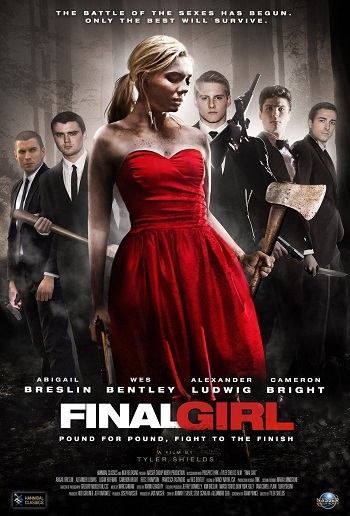
This article is a spoiler-heavy exploration of Tyler Shields’ 2015 thriller Final Girl. 1 This is not to be confused with Todd Strauss-Schulson’s The Final Girls or the overarching term “Final Girl”—which will be discussed.
Essentially, with its mix of action and horror tropes, Final Girl runs on the premise of “What if the seemingly innocent Final Girl being chased by the villains is a physically and mentally skilled assassin?” (Or, as one might also say, a “badass.”) As a young child in possibly 1950s America, Veronica is interrogated by William, a man whose past and occupation are unknown beyond a dead wife and daughter.
Despite her youth, Veronica possesses a rather blunt outlook on her parents’ premature demise (“people die all the time”), as well as an acute memory. Because of her demeanor and sharp mind, William recruits the girl to become a trained assassin who carries out missions at his behest.
Twelve years later, William still trains Veronica in certain techniques, such as how to perform a chokehold and how to endure drug-induced hallucinations that dredge up one’s greatest fears. Meanwhile, in the vein of Richard Connell’s short story The Most Dangerous Game, four men around Veronica’s age, likely in their late adolescence, send a woman fleeing into the woods before tracking her down and shooting her.
It turns out this is a habit of theirs—twenty young women terrorized and murdered for sport. The combination of the horror plot and the action girl is not an odd match. Another example of action and horror dovetailing is how the Alien franchise went from sci-fi horror (Alien) to sci-fi horror-action (the sequels). Both genres deal with violence and affecting the audience’s adrenaline.
The young men’s actions, reminiscent of 70s exploitation flicks, cross with Veronica’s talents as William tasks her with killing all four of them, a mission she relishes before it even starts. Veronica sets out to trick the four killers into believing her to be prey before she picks them off. Her four tuxedo-wearing targets are Jameson (the leader, trained to kill by his father), Danny (quite literally axe-crazy, enjoys upbeat rockabilly tunes and bad murder puns), Shane (has a girlfriend, Jenny), and Nelson (has a thing for his mother).
The horror and action film concepts present in this narrative are the Final Girl, the Pygmalion fantasy, the masquerade, and gender complements. Beginning with horror and moving to action tropes, the article will examine these different genre conventions in Final Girl and reveal how implementing them ultimately leads to subversions and inversions of cultural gender norms.
What is the Final Girl?
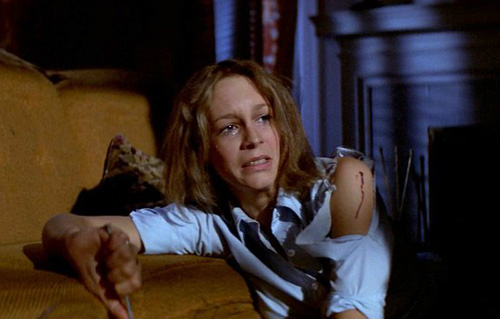
The aim here is not to applaud or deride the Final Girl trope, but rather to explore its complicated depiction in terms of gender dynamics. The term “Final Girl” originates from Carol J. Clover’s 1992 book Men, Women, and Chainsaws: Gender in the Modern Horror Film. 2 The female protagonist acts as a victim-hero (more emphasis on the “victim” part) who endures constant trauma—the loss of her friends and family, as well as the pursuit of a relentless killer.

Clover states, “It is with the Final Girl’s suffering that the film leads us to identify, not just narratively, but cinematically” (xi). Ultimately, in a genre mostly helmed by male creators, the Final Girl is a creation that leads the male audience to sympathize with her while she blurs gender norms. The film masculinizes the female protagonist through “phallic appropriation” (the Final Girl wielding a phallic weapon like a knife or chainsaw) and performs “the castration, literally or figuratively, of the killer at her hands” (49). As well as that, the Final Girl’s ambiguous gender associations equivocate the notion of men as active agents and women as passive (a notion discussed later in the article).
The Final Girl—
-Tends to be a young woman.
-May have a unisex name.
-Dresses modestly. May be more “homely” than peers.
-Is normally one of the sole survivors of the horror film’s primary threat—usually the only survivor in her friend group. Not only that, but she tends to be directly responsible for the killer’s downfall, though she may acquire help.
-Is typically a virgin. The narrative emphasizes the character’s lack of sexual experience, especially compared to her peers in a universe where engaging in sex often leads to mid- or post-coitus death.
-Abstains from drug and alcohol use.
-Might have a shared history with the film’s killer.
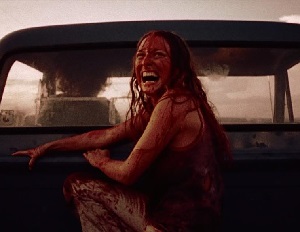
Examples: Sally Hardesty (Texas Chainsaw Massacre, 1974), Laurie Strode (Halloween, 1978), Ellen Ripley (Alien, 1979), Nancy Thompson (Nightmare on Elm Street, 1984), Sidney Prescott (Scream, 1996), Dana Polk (The Cabin in the Woods, 2012), Max Cartwright (The Final Girls, 2015)
In Final Girl, Veronica is a woman in her late adolescence with blonde hair and wide blue eyes. While the twelve years between her meeting William and the current events are left without much backstory on Veronica’s interactions with the outside world, she fashions herself into an unassuming, trusting young woman to entice the four killers so she can undermine them. The Final Girl trope is both subverted and adhered to in interesting ways.
Indeed, Veronica is not like Laurie Strode or Nancy Thompson as a young, not especially physically skilled young woman facing a supernatural threat. Laurie and Nancy are resourceful and use their wits as opposed to physicality, whereas Veronica is a trained assassin fully prepared and even excited about her deadly task.
However, the Final Girl is not just a victim, but a survivor as well, and Veronica fulfills the role of a young woman enduring and succeeding against a harrowing threat. Rather than the threat disrupting her life and destroying those she cares for, the aloof Veronica comes prepared with her own fighting prowess and a mixture to intoxicate her targets. In fact, Veronica is completely detached from the murder spree until she’s assigned the task to kill those responsible.
Concerning the Final Girl’s figurative castration of the threat, Veronica makes all the young men powerless. Danny, the first to die, is undone by his own axe as she plunges it into his chest. The pack leader, Jameson, is fond of guns as a source of power (established as early as when he kills Gwen Thomas in the woods after a short chase) and as a way to quickly kill his victims, but by the end, he is deprived of that means of violence and personal strength.
In the beginning of the movie, the sequence of Gwen Thomas’ attempted escape in murder in the woods plays from her POV as she watches her killers outnumber her, whereas Jameson’s comeuppance comes from his POV as the viewer witnesses his deterioration. The focus heavily goes to both Veronica and his hallucination of his victims coming to claim him.
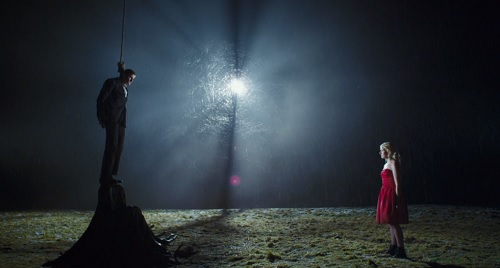
Whether the Final Girl is a potentially “feminist” construct is up for debate. Despite the ambivalence of gender norms, Clover argues that construing the Final Girl as female-positive is “a particularly grotesque expression of wishful thinking” (119) because the Final Girl as an paradoxical object-subject is merely a vehicle for the male viewer, which is why there exists the phallic weapon and the (sometimes) boyish names.
However, in The Monstrous-Feminine: Film, Feminism, Psychoanalysis 3, Dr. Barbara Creed argues that, beyond many Final Girls having feminine names, the “phallic woman” (woman with phallic or masculine attributes to put a male viewer at ease) and the “castrating woman” (the woman who disarms the male threat) are two separate beings.
The phallic woman lessens castration anxiety whereas the castrating woman, as the name suggests, does the opposite. While Clover argues the Final Girl appeals to a male viewership and assuages fear of castration, many slasher films do not “seek to resolve castration anxiety” (127). Therefore, the argument is that a male viewer would not be appeased by a Final Girl who renders a male villain impotent. If anything, the symbolic (Halloween) or literal (Teeth) castration causes tension because the aggressive feminine triumphs over the aggressive masculine, which is the case in Final Girl.
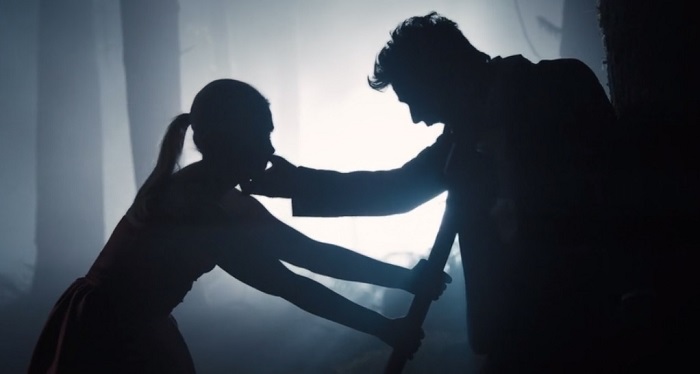
Creed goes on to speak about how the depiction of the monstrous feminine embodies a mythic uneasiness of female sovereignty. Still, both interpretations suggest something inherently discomforting about the Final Girl either being a) the assumed male audience’s stand-in or b) the object of male fear, while seemingly the Final Girl has no place with a female audience.
However, as pointed out by Dahlia Grossman-Heinze’s article on the Final Girl over at Bitch Media, Emily Nussbaum of the New Yorker argues that the appeal of a rape-centric show like Law & Order: SVU for women, even those who are rape survivors, is that the narrative creates a controllable fantasy of surviving and conquering trauma where said trauma is treated as the serious, primary conflict.
The show “has a strange therapeutic quality for any woman, a ritualistic confrontation with fear” 4 where the viewer can explore their own anxieties and fantasies without a real life punishment for their interest. Given the sexual and rape overtones of the Final Girl’s plight, Grossman-Heinze argues that Nussbaum’s conclusion about Law & Order: SVU‘s appeal can be applied to horror films and the Final Girls in terms of potential female enjoyment out of fantasy and empathy.
If a male viewer can experience fear through the “phallicized” woman, both men and women who fear assault of any kind can potentially connect with the Final Girl, even if mostly male directors have constructed such a character who fulfills certain attributes. Not only that, but the victory over evil and the satisfaction that comes with it also affects the viewer, not just the extended trauma.
Vengeance is Hers: the Final Girl as the Embodiment of Fear
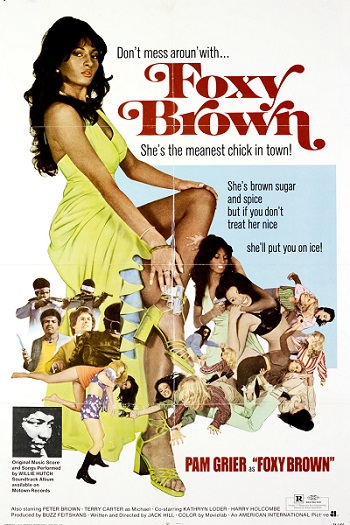
Final Girl falls into sheer revenge fantasy, despite Veronica having no intimate connection with the threat, but rather willingly pushing herself into the fray for enjoyment. In terms of horror and exploitation, it is in line with rape-revenge and murder-revenge films.
Films like Ingmar Bergman’s The Virgin Spring (1960) and Wes Craven’s The Last House on the Left (1972) deal with the rape and murder of female offspring and the parents avenging them. Jack Hill’s Foxy Brown, a Blaxploitation film featuring Pam Grier (who kickstarted the action heroine genre with roles like Coffy and Foxy Brown), deals with the eponymous character avenging her murdered lover.
Then, in rape-revenge, a shift occurred where women avenged their own trauma rather than someone else accomplishing the gruesome task. Meir Zarchi’s I Spit on Your Grave (1978), originally titled Day of the Woman, and Abel Ferrara’s Ms. 45 (1981) depict their respective protagonists, Jennifer and Thana, coping with their post-rape pain and isolation. Thana goes on a murder spree allegedly for the plights of wronged women after executing her second rapist in self-defense, and her motivation and state of mind each grow murkier as the film progresses.

With perhaps a further-blurred motive, in David Slade’s 2005 thriller Hard Candy, fourteen-year-old Hayley Stark, played by Ellen Page, takes it upon herself to avenge raped and murdered girls because she views herself as the embodiment of every rape victim seeking justice, despite rejecting the notion that she has been abused.
Essentially, the films given above go from victims brutalized and avenged post-mortem to victims avenging the crimes themselves to a further graying and smearing of motives. Then, Final Girl creates a tale where the (anti-)heroine, while avenging the deaths of twenty women, has no personal involvement with the victims or assailants until William assigns Veronica the mission.
In writing about Hard Candy and Mitchell Lichtenstein’s 2007 black comedy/horror film Teeth, specifically honing in on the subjects of post-trauma identity and castration anxiety, C. Henry states in her book Revisionist Rape-Revenge: Redefining a Film Genre 5 that certain female-focused revenge thrillers “chart the loss of a sense of self” (Losing Their Bite, para. 3). The emotional weight shifts from concern to dark intrigue. Henry goes on to say Hayley, through embodying herself as her targets’ collective pool of victims, becomes a “mythical feminist avenger” (para. 4).
Movies like Ms. 45 and Teeth deal with a rape victim protecting herself and then devolve into the protagonists harming less violent or nonviolent acquaintances and strangers. Hard Candy’s anti-heroine has no solid identity and therefore the audience has no grip on her background and whether she has a traumatic history or only sees pedophiles as easy and unsympathetic murder targets.
With Final Girl, Veronica shifts her identity and feigned allegiance as well by wielding the masquerade, which will be examined. On a meta-level, the carnage pleases the audience who will relish the destruction of a group of misogynistic sadists. In a strange way, the Final Girl becomes a force of nature or the monster. Horror characters like Friday the 13th Part 2‘s Jason Vorhees and Halloween‘s Michael Myers are associated with fear and nature. Michael Myers’ reasoning for his actions is simply evil without explanation. As their stories progress, many of their victims possess no association with them or any past wrongs.
Through her violence, Veronica avenges girls like Gwen Thomas and intentionally invokes terror with a drug cocktail that makes an individual witness their greatest fears. She induces hallucinations for the male assailants by offering them spiked alcohol and reversing the hunter-prey dynamic as they plan to chase and kill her. Veronica’s targets witness their deep-seated fears—from men in panda masks (jury’s out on this one) to maternal abandonment mixed with Oedipal desire to romantic betrayal to comeuppance embodied by several victims emerging from the dark woods. In this way, Veronica crafts herself into the most fearsome power in the forest.
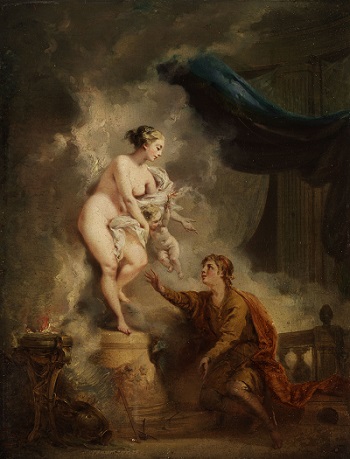
“Pygmalion” (1857)
The Pygmalion Fantasy
In Greek mythology, Pygmalion is a sculptor who fell in love with a sculpture he created, a sculpture later turned human by Aphrodite, the goddess of love. In action films, beyond a good deal of male creators being involved in their conception, many movies depict the action heroine receiving training and learning her skills from a male instructor who may be solitary or part of a larger organization that commands the female protagonist. Examples of such are Le Femme Nikita and its American remake Point of No Return, as well as Kill Bill and Hanna.
For TV shows, there’s Buffy the Vampire Slayer, which plays with its own share of horror and action tropes. Rupert Giles watches over Buffy’s training, and the Watchers’ Council, a large male unit, oversees the Slayers, who are all depicted as female. Even earlier than that, Charlie’s Angels features women who work for a male boss.
In his book Dangerous Curves Action Heroines, Gender, Fetishism, and Popular Culture 6, Jeffrey A. Brown notes Pygmalion scenarios as “young heroines bred or trained by father figures/patriarchal institutions” (85). This may only be in terms of desire with no consummation, such as in Point of No Return between Maggie and Bob, a government agent, but ultimately “the action heroine is presented as a product of male design” and “we routinely see men of authority taking uniformed girls and transforming them into highly valued and sexually exciting killing machines.” Others examples include River in Joss Whedon’s Serenity (2005) and Alice of the Resident Evil film series.
Perhaps one of the more upfront examples of a fully realized Pygmalion relationship in an action film is the relationship between Beatrix and Bill in Kill Bill, in which Bill acts as the leader and teacher for the DiVAs, a group of female assassins, and he and Beatrix sustained a romantic and sexual relationship prior to pt. 1’s opening. Kill Bill, pt. 2 emphasizes mix of patriarchal authority and romantic attraction by having Beatrix temporarily pretend Bill is her father while introducing him to her fiance.
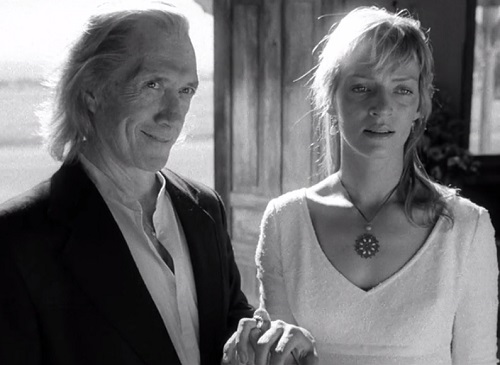
Final Girl interacts with the Pygmalion fantasy in an extremely direct manner. More than just chemistry, Veronica desires to have William, her mentor and surrogate father since she was a child, as her lover. Earlier in the film, the both of them are staying in a two-bed hotel room. William rests on the bed, and Veronica emerges from the bathroom in a white towel. She moves beside him and, being very to-the-point, attempts to seduce him to no avail. When Veronica insists to rest with him, William rebukes her by saying she has her own bed.
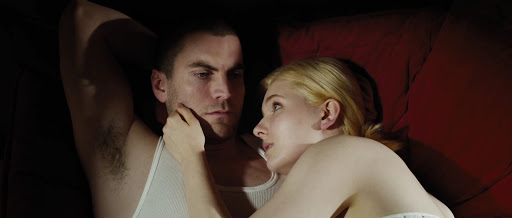
In the next scene, William straps Veronica to a table and places her under the effects of a drug cocktail meant to teach her what being under the influence of DMT is like so she knows her victims’ mentality when she later spikes their drinks. In this sequence, Veronica faces her greatest fear, and that is revealed to be William betraying her. Before Veronica goes off on her mission to kill the four young murderers, she writes I love you on her mirror in lipstick, most likely for William in case she doesn’t return.
The film provides a complex relationship ripe for tension. However, Veronica’s complicated feelings for William take a backseat once the main conflict proceeds because he doesn’t reappear until the film’s conclusion. Even so, despite the mentor-trainee relationship being sidelined halfway through for the primary conflict, Final Girl takes a common action film trope and presents Veronica’s desires for the widowed, highly skilled patriarch in a straightforward way.
The Masquerade

The feminine masquerade, a concept introduced in British psychoanalyst Joan Riviere’s “Womanliness as a Masquerade,” entails a female character taking on traditional female attributes as a defensive mechanism or a way to lure and undermine male authority. This goes back to (mostly figurative) castration anxiety, where the masquerade is a feminine tool to be feared. Typical ways of performing the masquerade are donning make-up, most prominently red lipstick, and “sexing up” to appeal to the heterosexual male libido.
In Final Girl, Veronica performs the masquerade by dressing in a red dress and wearing bright lipstick in order to appeal to her targets so she can weave her way into their domain in a nonthreatening manner. Not only that, but she fools them into believing she’s demure and docile. She even feigns terror when the four young men reveal their true intentions.
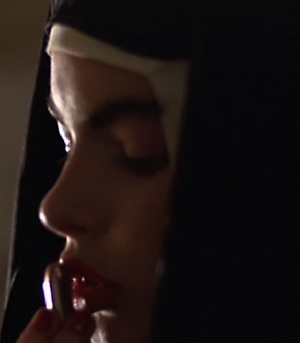
Veronica’s chameleon-like shift does not only occur when she’s on her mission, but rather it stays with her throughout the film. Her wardrobe is the most conspicuous marker. In the current time, Veronica’s dress colors consist of black, white, and red at different moments. Barring her white towel when she attempts to seduce William, she tends to wear black until she needs to ensnare men the first time around. Then, she wears a modest white dress, which is what Gwen Thomas, the four killers’ only named victim, wears before and during her death.
Veronica wears the white dress when coyly luring a man to an alley so he can be assaulted for information and later when she first speaks to Jameson and tacitly convinces him to take her out on a “date.” In this way, the white dress is re-coded from representing victimhood to asserting dominance, which is crucial when Jameson hallucinates Gwen and his other victims coming to avenge themselves. They emerge from the woods—Gwen in her white dress and the other victims in black dresses, all pieces of attire Veronica has worn previously.
Then, once the hunt starts and Veronica had her red lipstick, she also adorns herself in a red dress, which enhances the Jameson’s attraction to her. 7 Every aspect of this is an intentional way to appear attractive and nonthreatening while proving herself to be the opposite. Overall, gender becomes performative—a part to play, an outfit to don or shed depending on the circumstance. This manipulation reveals an underlying unease of weaponized traditional femininity.
Gender Complementarianism
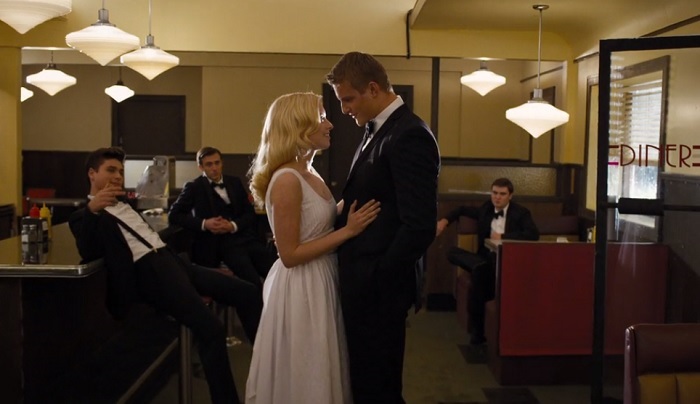
Gender complementarianism is the subjective notion that men and women are opposites and therefore balance one another. With this concept, the sexes work on an assumptive binary: men as active and women as passive; men as aggressors or saviors and women as the victims or the rescued. In action films, gender complementarianism may appear in many forms from the damsels in distress to characters adhering to “traditional” roles and stereotypes to compulsory heterosexual unions. Movies can maintain, subvert, deconstruct, or altogether dismantle this notion.
In The Violent Woman: Femininity, Narrative, and Violence in Contemporary American Cinema 8, Hilary Neroni speaks of war and military films such as Ridley Scott’s G.I. Jane (1997) in the sixth chapter. After discussing gender complementarianism and how the violent woman unsettles stark boundaries, she concludes—
“The very nature of this struggle on film and in the military indicates the peculiar trauma that the violent woman causes American society. Though recent military films such as Saving Private Ryan and The Thin Red Line (1998) break from traditional depictions of masculine violence, they do not break the link between masculinity and violence. As long as this link continues to exist, the status of the violent woman will continue to be traumatic.
Disturbing the complementary nature of the male/female relationship, the violent woman will continue to be a volatile nexus for many unanswerable contradictions in society—contradictions evident in the structure of both Courage Under Fire and G.I. Jane. Thus, even though we see more and more women entering the military, their sheer numbers do not in any way put us closer to a resolution of the antagonism that the violent woman brings to light. She does not offer resolution but something more important: she continues to do us the service of laying bare our wounds” (84).
Final Girl both portrays and challenges the idea of gender complements. Violence and masculinity are indeed linked because of the pack of homicidal male youths. However, as a violent woman, Veronica indeed defies the notion of women as solely passive and in need of protection. Once more, even though the masquerade is an act, she is still feminine without that performance and not portrayed as overtly masculine, so here masculinity does not necessarily always correlate to making a violent individual.
In fact, Veronica exploits the presumption of the nonviolent woman by acting defenseless to trick her targets. However, violence being the barrier-breaker is questionable in terms of if it breaks barriers or only maintains aggression as the status quo—but nevertheless, it does equivocate the notion of stark, rigid gender lines. This coincides with what Jeffrey A. Brown speaks about when it comes to masochism and one of the differences between the Final Girl and the action heroine.
The action heroine not only defies the notion of being passive, but she “unwaveringly and violently refuses to assume a masochistic position within the narrative” (232). Ultimately, her bodily autonomy, including her sexuality, no matter how exaggerated or how connected with the main villain, is not used to undermine her or cause her trauma. The action heroine is not punished or rendered permanently vulnerable for her societal transgressions and dominance. Veronica does not act as a victim-hero, but rather maintains her autonomy throughout.
Beyond Shane and Jenny, who experience relationship turmoil prior to the former’s demise, the heavily suggestive relationship between Nelson and his mother is perhaps the closest to a spousal heterosexual relationship. The viewer receives mundane dinner scene as the two occupy opposite sides of the table. Later, Nelson has a moribund vision of kissing his mother after he suffers the effects of the drink Veronica spiked.
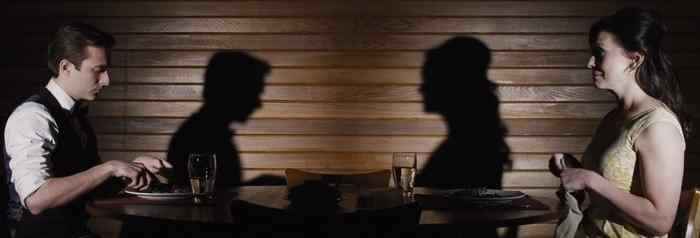
The Oedipus complex stems from castration anxiety (NSFW). In Greek mythology, Oedipus was sent away as a baby to die after his father, King Laius, learned that Oedipus was fated to kill him and marry Jocasta, the queen and Oedipus’ mother. Despite being sent away, Oedipus unknowingly does both when he’s an adult, which ends in disaster and him blinding himself with his dead mother-wife’s brooch.
In the cursory psychoanalytic perspective of mother-son attraction, the Oedipus complex deals with the infant developing a longing for his mother. The family patriarch, the son’s father, acts as a rival for the mother’s affections, and the child fears punishment from the father for his attraction to his mother. Noticing his biological mother’s lack of a penis, the son fears the consequence for his transgression will be just that—the absence of a penis, or the forcible removal of his genitals. Normally, fear of castration overrides any sexual desire for the mother.
Concerning Nelson and his mother, a father is noticeably absent in the above family structure. Nelson mentions him in the past tense, though the circumstances of his lack of presence are never expounded upon. Here in Final Girl, there is yet another example of an issue that causes castration anxiety. The masquerade acts as a way to ensnare undermine male authority, which causes dread, and Nelson’s relationship with his mother affects his psyche to the point that her abandonment of him becomes his greatest fear as he hallucinates and faces death at Veronica’s hands.
During Final Girl’s last confrontation, rather than grieve his dead brothers in crime, Jameson essentially proposes to Veronica because he admires her homicidal instinct, but other than that and Veronica and William’s unrequited affection, there is little to uphold the strict boundaries of men and women only having certain talents or inherent natures.
As mentioned above while discussing the masquerade, Veronica’s wardrobe re-codes the boys’ victims’ attire, and in the end, said victims are seen as imagined entities bent on seeking vengeance against Jameson. The shot of them encroaching and determined blurs their own roles as the sparsely mentioned victims of the masculinized horror movie killers because they are allowed to be a part of Jameson’s ultimate demise. In the end, Jameson is the one forced into passivity and futile pleading.
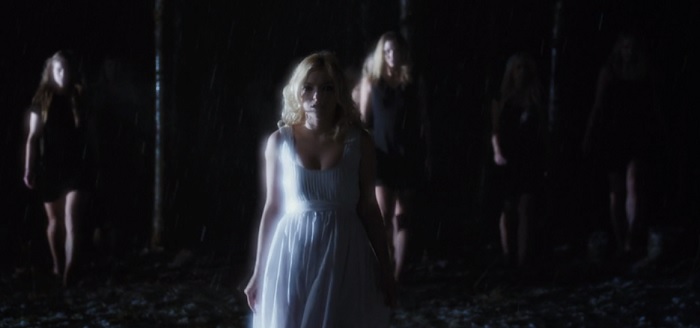
With its roots in more than one genre, Final Girl encompasses many gender-centric horror and action tropes. Veronica is not only a force to be reckoned with, but, like action heroines before her, she forces a reckoning upon the film’s antagonists. The pastiche provides multiple opportunities to explore how past, current, and future films can and will interact with concepts like the Final Girl or Pygmalion fantasies, which contribute to the viewers’ knowledge on how the movies and other media they consume interact with societal issues.
In the end, it will be fascinating to see how future horror and action films, thrillers, and so on perpetuate or deconstruct ideas of how men and women engage with each other, whether in solidarity or opposition. Media does not exist in a vacuum. As Hilary Neroni says, such depictions of these societal problems assist the audience because even if the films do not absolve the issues they tackle, they still lay bare cultural wounds.
Works Cited
- Final Girl. Dir. Tyler Shields. Perf. Abigail Breslin and Wes Bentley. Cinedigm, 2015. Netflix. ↩
- Clover, Carol J. Men, Women, and Chainsaws: Gender in the Modern Horror Film. London: BFI, 1992. Print. ↩
- Creed, Barbara. The Monstrous-Feminine: Film, Feminism, Psychoanalysis. London: Routledge, 1993. Print. ↩
- Nussbaum, Emily. “Trauma Queen: The Pulp Appeal of Law & Order: SVU.” The New Yorker. Condé Nast, 10 & 17 June 2013. Web. 24 Mar. 2016. ↩
- Henry, Claire. Revisionist Rape-Revenge: Redefining a Film Genre. USA: Palgrave Macmillan, 2014. Print. ↩
- Brown, Jeffrey. Dangerous Curves: Action Heroines, Gender, Fetishism, and Popular Culture. Jackson: U of Mississippi, 2011. Print. ↩
- “Psychological Study Reveals That Red Enhances Men’s Attraction to Women.” Rochester News. University of Rochester, 28 Oct. 2008. Web. 29 Mar. 2016. ↩
- Neroni, Hilary. The Violent Woman: Femininity, Narrative, and Violence in Contemporary American Cinema. Albany: State U of New York, 2005. Print. ↩
What do you think? Leave a comment.











This is a movie to watch on a rainy day.
Thanks for the comment. I can definitely see what you mean!
I agree.
I like the way the movie looks like a mishmash of a 1920’s(?) movie and a modern day 2016 film. i also REALLY liked the extreme (but beautiful) lighting in the forest.
Agreed. The time period was a little confusing with the mixed technology. I think with one of the killers being greaser-like, it was supposed to be 1950s-ish with a mishmash of other elements. The lighting was incredibly effective at certain points, catching a very stark juxtaposition between dark and light.
This by far the most contrived, overacted nonscensical film i’ve seen in years and it provides one of the most hideous miscast actresses i’ve ever witnessed. It should be shown to everyone at film school on their first day.
There were moments of overacting…and underacting. There were also times when the plot did seem contrived, or at least it was strange that certain characters appeared at specific locations. Overall, I enjoyed Final Girl on a pure entertainment level, but I can understand why it would frustrate the viewer.
I’m going to persuade my friends to watch this with me, they’ll love it.
Cool, I hope they enjoy it!
This is the type of movie to watch when you have nothing better to do and need to kill some time
Haha, I may have watched this when it was a late night and I was scrolling Netflix….
An awesome read! You psychologised a seemingly innocuous and, consequently, ubiquitous component of many films of the genre in a really interesting way. Nice analysis and you’ve definitely presented me with a plethora of films I must watch!
Thank you! I took a class about actions films with female leads, so I had a lot of references at my disposal. 🙂 I was surprised with how much of those concepts I saw in Final Girl, such as the blatant Pygmalion fantasy, but like you said, these are tropes so ubiquitous that it’s actually not surprising at all.
Great analysis, I love how you linked the Pygmalion fantasy concept with the final girl term.
It did shed light on things I never really thought about before, like the power relationship between Rupert Giles, the Council and Buffy, a subject that is worth researching.
Would Hayley Start be considered a final girl in your opinion since she’s the sole survivor of these pedophiles, or should another term be borrowed or even created for these types of characters?
Thanks for a great read!
Thanks! 🙂 I’m glad I could connect the power dynamics to other media, such as Buffy. It’s interesting thinking about the prevalence of super-strong girls and how they tend to have male mentors.
With Hayley Stark, it’s complicated because horror is a diverse genre, and it’s arguable whether Hard Candy could be considered horror, since the line between horror and thriller is so blurry. Final Girl itself is a union of multiple horror and action tropes that collide because horror and action are both seen as lowbrow because they’re “of the body.” (Damage to body parts, characters suffering, etc.)
Hard Candy definitely takes on a lot of attributes of horror/exploitation rape-revenge films, where rape is avenged by the survivor, the survivor’s loved one(s), or another party. Hayley is a rape/abuse avenger who makes herself a symbol for every single victim of Jeff’s, making herself a larger-than-life force of nature, similar to how Michael Myers and Jason Vorhees are associated with nature and almost dehumanized by how abstracted they are.
Characters like Hayley and Veronica from Final Girl, who are forces to be reckoned with, are more like subversions of what is considered a final girl. They both, like Laurie (Halloween) and Nancy (Nightmare on Elm Street) face (mostly male-coded) threats and use wit and/or phallic weapons to fight the monsters. However, Hayley and Veronica are not exactly horror or rape-revenge victim-heroes, as Clover would say. They both use the masquerade to pretend to be vulnerable, and the vulnerability of final girls is often meant to make them an audience surrogate for predominantly male viewers, but that is ultimately a facade to manipulate their targets. Hayley essentially flips the cat-and-mouse script so Jeff’s the one running and trying to escape.
It’s possible Hayley can be called a final girl, or at least the final girl and Clover’s thoughts on horror and rape-revenge films can be applied to her presentation. I’d be curious to see if another term could be applied for a character meant to deconstruct the final girl trope by secretly being the stronger threat rather than a character with danger and trauma forced upon them who struggles to survive and (normally) comes out on top. The thing about Hayley and Veronica is that they willingly seek out their prey.
This was a really interesting read, with a great analysis! I loved how you used psychoanalysis (and some Freudian theory) to deconstruct the trope of a Final Girl. Something that I found really interesting was your point about the presence of a male mentor. I never really thought of it, but in most media we do see a male mentor of some sort, and there’s some kind of subverted relationship. I actually haven’t seen the movie yet (whoops), but I’ll definitely be checking it out soon! Great job, your writing good as well, very clear and easy to understand 🙂
Thanks! I’m glad you enjoyed the article. 🙂
Lovely analysis.
Thanks!
It felt obvious to me as a viewer that this film was made on a budget.
There was some…very questionable CGI, so I see what you mean.
The film feels like the last 10 minutes of a stage play you walked in on.
Yeah, I wish the film focused more on building its primary characters.
Never have I seen a film that seemed so disinterested in telling me anything about how or why these people are who they are. The backstory’s are practically non-existent.
I see what you mean. I wish Final Girl took the time to build up Veronica and William. I wasn’t entirely sure of William’s background. Cop? FBI agent? Assassin? Part of spy organization? Maybe the film said it and I missed it. I also wish it didn’t jump from when they first meet to Veronica’s late adolescence.
I saw it on Netflicks and clicked on it because I like Abigail Breslin and Wes Bentley.
I like them too! Breslin is in another Netflix movie called Haunter, which I have on my list.
I really want to watch this movie. It reminds me of the Scream Queens tv series that came out this year.
Yeah, I haven’t watched Scream Queens, but if you want a pretty self-aware, trope-y movie with a female lead, Final Girl is pretty fun. 🙂
Do you know who runs this website? I just discovered it today. Is it only Concordia students?
Sorry if I misinterpreted your question, but anyone can write for The Artifice, regardless of education or location. (I’ve never been to Concordia.) If you’re a user, you can post articles, submit topics, and peer review other writers’ posts, so the site runs on user participation. All you have to do is register (for free) and complete a few steps. Here’s a page with a registration link at the bottom: https://the-artifice.com/write
Hope that helps!
Yes, I have registered already! Thanks so much for the help 🙂
Awesome! If you have any general concerns, you can post questions on the Newsdesk, and I think you could also PM Misagh. Good luck. 🙂
Abigail Breslin doesn’t seem in place tbh.
I’ve seen that sentiment a lot, and I respect it. I wasn’t put-off by her casting, but I’m also not really familiar with her outside of Signs.
I agree. This is one of the worst films I have seen. I think Abigail is a good actress, but anything physical she did in this movie was completely unbelievable as in I didn’t buy it for a second.
Loved the quirky characters.
Agreed. Though most of the characters didn’t seem to have arcs, I enjoyed that the four villains were given distinct personalities.
GREAT film study, but the film is not meta and it’s not self-aware. It’s cliche and tired.
Thanks! 🙂 I would argue it is self-aware, but whether it executes that self-awareness in a fresh or clever way is debatable. Many films take established tropes and try to subvert them, such as the final girl here, but they may not always succeed because of other problematic aspects of the film. Some films use that self-awareness as a cover for shallow characters and a contrived script. I don’t think that’s always a conscious decision on the directors’ parts, but it can be a way to try to freshen up the content without succeeding.
Really enjoyed The Pygmalion analysis of the film. This article also does a fantastic job of great job of breaking down some gender binaries in the sense that there is a reason for the females to be dressing themselves up in an overly sexual fashion and that there is a darker way to be appeasing to the male gaze. When thinking of the female character in such a manner it is kind of reminiscent of femme fatales, but taking on a more aggressive shape.
It is structured like a comic book.
this movie had so much potential. i don’t hate it but there’s just way too many things (story-wise) that don’t make sense (and i’m talking in OVERT, GLARINGLY BAD ways!).
I haven’t yet seen Final Girl, but have studied the final girl trope this year and am very interested to watch it now. Your review of the trope and its many incarnations is extensive and impressive. One horror/thriller trope that may contribute to a discussion on the role of gender in horror film is the transgendered killer (such as the villains in Silence of the Lambs and Dressed to Kill). The depiction of these killers could tie in nicely with your discussion on Oedipal castration anxiety (particularly the one in Dressed to Kill).
Her fight scenes were a bit stiff and sluggish.
I really enjoyed the The Pygmalion analysis, mostly because it is not something that people study often. It is interesting.
As for the movie itself… I can’t say I’m a fan haha.
I felt confused and lost after this movie. Sure I was entertained watching her kick ass, but I would have liked for there to be more substance to the plot. They could’ve done so much with this movie, but it feels like Sheilds was either short on time or money or both.
It looks like a ’90s music video!
Thoughtful and well researched, kudos! Cabin in the Woods (referenced above as an example of the Final Girl) was meant to be satire illustrating your very point regarding the gender norms, suffering, strength in trauma, etc, rather than another trope of a character fitting the mold. Regardless, all of your points were well taken and I appreciate the insight.
This movie had an interesting premise but totally failed to deliver… So many interesting directions they could have gone, from (REVERSE SPOILERS) having Veronica’s parents be the serial killers who killed Bentley’s parents, to her being her parents’ killer… basically, an interesting premise, a flawed script, and TERRIBLE editing/directing… The way it doesn’t live up to its potential actually makes it worse than if it had been just bad…
This makes me want to watch this now. Fascinating analysis.
A fascinating read. I’ll definitely be watching this movie soon.
This is an intriguing article that touches on a lot of significant ideas related to film theory. Makes me want to revisit my film theory classes I took in undergrad. Have you read Tania Modleski’s analysis of femininity/sexuality in Hitchcock films? I think you would like it!
Quite surprised to see I Spit on Your Grave being referred to positively in regards to female empowerment. This has also my argument, although many critics have argued to opposite based on Jennifer using sexuality as part of her revenge. I never understood this argument since Jennifer’s use of sexuality during the revenge stage shows how she was able to exploit the rapists’ horrific attitudes and make them pay.
Very interesting take on the history of heroines in horror films. An intriguing read!
This was an odd movie–OK but nothing special. Despite that, a good essay.